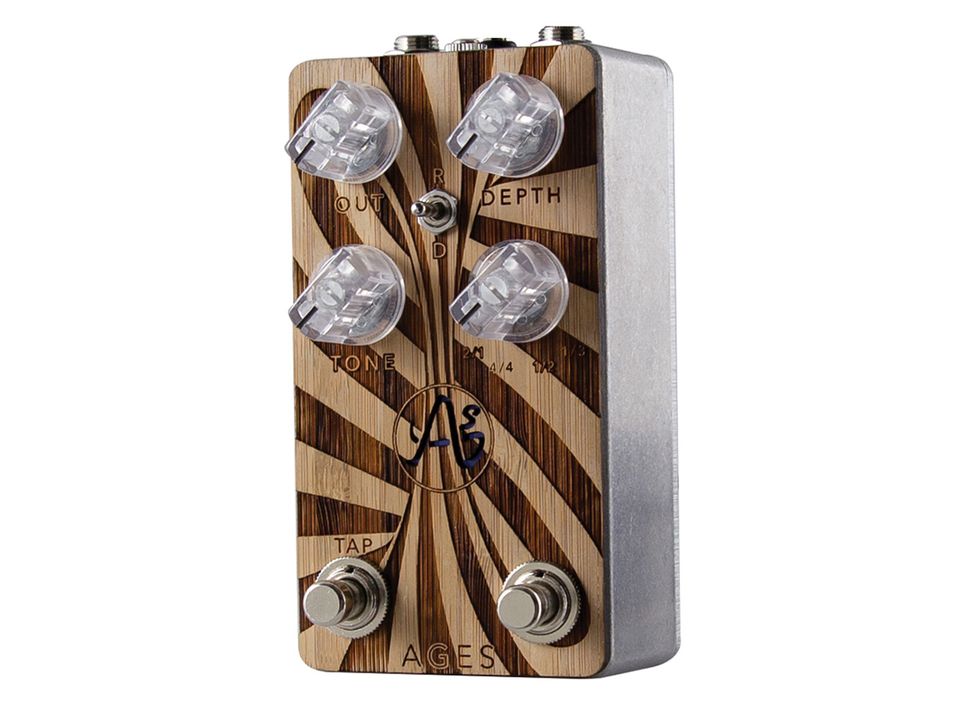Recorded using a Telecaster with Curtis Novak Tele-V and JM-V pickups into a silver-panel Fender Vibro Champ with a Warehouse G8C miked with a Royer R-121 feeding an Audient iD44 going into GarageBand with no EQ-ing, compression, or effects.
Clip 1: Bridge and neck pickup, first with Ages bypassed, then engaged with out at 3 o’clock, depth at noon, and tone at 10 o’clock.
Clip 2: Neck pickup, first with Ages bypassed, then engaged (with triple-cosine waveform selected) in envelope-controlled rate mode, then envelope-controlled depth mode, with out at 4 o’clock, depth at max, and tone at 3 o’clock.
RatingsPros:Lots of lovely tones. Very flexible for its size. Cool attack-sensitive modes. Cons: Can be time-consuming to dial preferred internal settings. No expression-pedal jack. Manual and control labels could be clearer. Street: $250 Anasounds Ages anasounds.com | Tones: Ease of Use: Build/Design: Value: |
The term “harmonic tremolo” is almost a misnomer. Most classic tremolo sounds come from amps using a light-dependent optocoupler or either power- or preamp-tube bias shifting to modulate the volume of your guitar signal. But the harmonic effect popularized by 1960s Fender brown-panel amps splits your signal in two—bass and treble—and modulates them in opposition to each other. The net effect—typically colored with grit from the three 12AX7s used to drive it—often sounds more like pitch shift than other tremolo types. Magnatone’s famous vibrato, which is often lumped in the harmonic tremolo category, uses phasing and filters to achieve a similar pitch-shifting modulation effect.
French outfit Anasounds’ new take on harmonic tremolo is the deceptively simple-looking Ages. Even more ambitious than its innovative and pedalboard-friendly Element spring reverb, it packs a host of options into an enclosure with just four knobs, a 3-way toggle, and two footswitches.
Tweaky or Freaky?
Depending on your proclivities, Ages’ controls might seem ingeniously streamlined or a test of your cranial recall capabilities. Because although the basic functions of controls—tap/osc(illation) and bypass footswitches, the mode toggle, and out (effect gain), tone, depth, and subdivisions knobs—are mostly grok-able by name, several hidden options lurk within.
For starters, if you hold down the bypass footswitch for two seconds, the tri-color LED turns from either blinking red (bypassed) or white (engaged) to blue, indicating you’re in “trimpot mode” (which, as we’ll see, is somewhat confusingly named). Trimpot mode enables control of several parameters, including two favorite—and rarely encountered—features in a tremolo pedal: attack-sensitive rate and depth modes. Here, the tone knob becomes an envelope control governing either rate or depth of the effect (depending on the mode you select with the toggle).
If you turn the tone/envelope control left from noon, rate or depth decreases with greater pick intensity. If you turn clockwise from noon, rate or depth increases with greater pick intensity. Meanwhile, in trimpot mode, the depth dial works hand in hand with tone/envelope—becoming a threshold control for the rate- or depth-ramping effect. Lastly, trimpot mode can repurpose the toggle and subdivision knob so you can select one of seven different LFO waveforms (sine, rising-ramp, falling-ramp, square, polynomial, double cosine, and triple cosine). Once you’ve set the waveform, envelope, and threshold, you tap the bypass toggle to save them, then re-position the knobs and toggle to your desired depth, tone, and mode settings.
Dizzy yet? Hold on, because we haven’t even talked about the actual trimpots—oh, and the DIP switches! Be prepared to crack open Ages because, depending on your pickups, these controls could be the difference between loving your Anasounds and not. Two trim pots fine-tune the tone knob by increasing or reducing the range of available treble and bass gain. Two more trim pots govern the minimum and maximum amplitude (range) of the LFOs. And two DIP switches toggle between preset frequency-filter points for the bass LFO, and the treble LFO.
The Verdict
The Anasounds Ages can do so much that it’s hard to cover it all here. At its core, it serves up lush, inspiring harmonic trem sounds with way more control than any vintage amp. But it’s not without its quirks/frustrations: There’s no expression input, yet there’s a mini jack for connecting the company’s magnetic-sensor Spinner product ($140 street). I give Anasounds creative points for thinking outside the box, but this exclusion feels like you’re being nudged toward a proprietary additional purchase with very limited applicability (Spinner currently only works with one other Anasounds pedal). That said, the Ages’ ability to shape tones—deliciously nasty, tweed-style dirt, with a cool cocked-wah EQ curve, for instance—while offering powerful dynamic control options, make it a unique-sounding tremolo powerhouse.








![Rig Rundown: Russian Circles’ Mike Sullivan [2025]](https://www.premierguitar.com/media-library/youtube.jpg?id=62303631&width=1245&height=700&quality=70&coordinates=0%2C0%2C0%2C0)

















